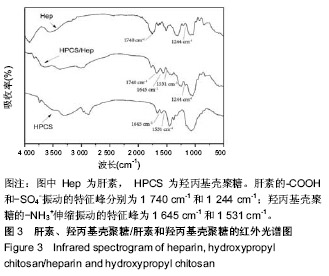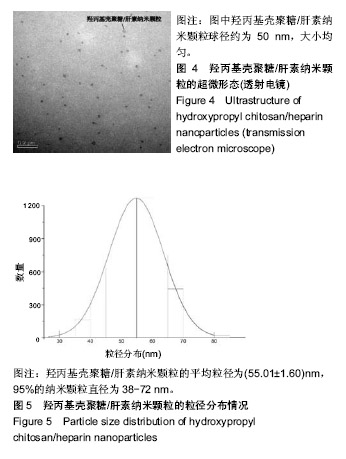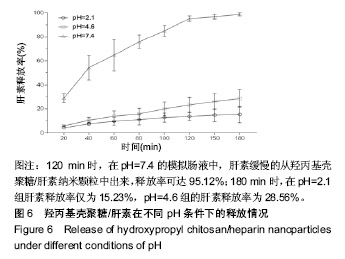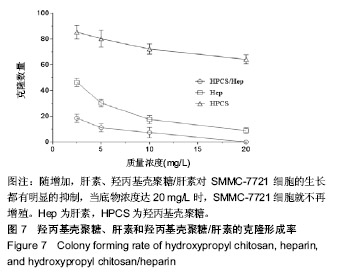中国组织工程研究 ›› 2019, Vol. 23 ›› Issue (22): 3536-3541.doi: 10.3969/j.issn.2095-4344.1280
• 药物控释材料 drug delivery materials • 上一篇 下一篇
羟丙基壳聚糖/肝素纳米载药体系的制备、释放及抗肿瘤特性分析
杜建红1,范春水1,杜月莲1,孙笑宇1,王庆峰2
- 1山西药科职业学院制药工程系,山西省太原市 030031;2辽宁中医药大学基础医学院,辽宁省沈阳市 110032
Preparation, sustained release and anti-tumor characteristics of hydroxypropyl chitosan/heparin nano-drug system
Du Jianhong1, Fan Chunshui1, Du Yuelian1, Sun Xiaoyu1, Wang Qingfeng2
- 1Department of Pharmaceutical Engineering, ShanXi Pharmaceutical College, Taiyuan 030031, Shanxi Province, China; 2Basic Medical School of Liaoning University of Traditional Chinese Medicine, Shenyang 110032, Liaoning Province, China
摘要:
文章快速阅读:
.jpg)
文题释义:
羟丙基壳聚糖:作为常见的纳米载药材料,壳聚糖有着较好的生物相容性,可以和血液、器官等相容,且安全性较高,亦有较好的生物降解性。然而,在实际的应用中,壳聚糖的水溶性往往不足,因此,可以在壳聚糖上引入羟丙基,从而增加其水溶性。
肝素抗癌:作为一种抗凝剂,肝素是由二种多糖交替连接而成的多聚体,在体内外都有抗凝血作用。然而,随着现代的研究发现,肝素也有较好的抗癌活性,其可抑制肿瘤血管的生成,通过对选择素的抑制,直接抑制肿瘤的转移,同时抑制肝素酶的活性,从而起到抗癌的作用。
背景:肝素类药物在人体内使用时,存在毒性大、代谢时间短等临床问题。
目的:制备羟丙基壳聚糖/肝素纳米载药体系,考察其载药量、微观形貌、粒径分布、体外释放及对肝癌细胞的抑制效果。
方法:设置肝素溶液与羟丙基壳聚糖溶液体积比为3∶10,6∶10和9∶10,以电荷吸引制备获得羟丙基壳聚糖/肝素纳米颗粒,考察所制备颗粒的性质。考察该颗粒在pH=2.1,4.6,7.4的PBS中的24 h释放率;培养肝癌SMMC-7721细胞株,接种于96孔板内。同时向平板内添加2.5,5,10,20 mg/L的肝素、羟丙基壳聚糖及制备的羟丙基壳聚糖/肝素纳米颗粒混悬液,分析细胞培养24 h后的细胞抑制率。
结果与结论:①肝素溶液与羟丙基壳聚糖体积比为3∶10,6∶10和9∶10时,载药量分别为(27.13±0.79)%,(36.39±1.12)%及(43.68±1.45)%;②肝素溶液与羟丙基壳聚糖体积比为6∶10时制备的纳米颗粒在pH=7.4的条件下释放肝素的速度,远快于pH=2.1或4.6时,且该颗粒在6 h可释放95%以上的肝素。同时释放速率同肝素的负载量成正比;③羟丙基壳聚糖溶液对肝癌SMMC-7721细胞株没有明显的抑制作用;而随着溶液浓度的增加,肝素对肝癌SMMC-7721细胞株的抑制率显著增加,且肝素溶液与羟丙基壳聚糖体积比为 6∶10时制备的羟丙基壳聚糖/肝素颗粒的抑制率高于单独使用肝素时;④结果表明,以肝素溶液与羟丙基壳聚糖体积比为6∶10时制备羟丙基壳聚糖/肝素纳米载药体系具有pH选择性缓释作用,且对肿瘤的抑制效果明显。
中图分类号:




.jpg)
.jpg)
.jpg)
.jpg)